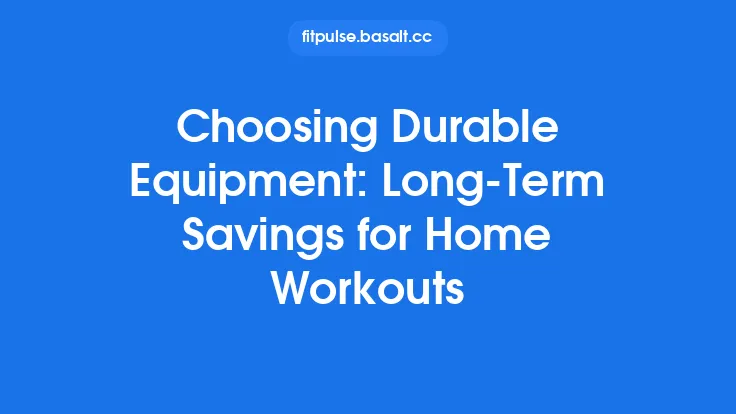When you’re planning a home gym, the equipment itself is only part of the equation. Even the best‑priced machines and accessories can quickly become a financial strain if you buy them at the wrong time. By aligning your purchase schedule with the natural ebb and flow of retail promotions, you can shave a significant percentage off the sticker price, stretch your budget further, and still end up with a fully functional workout space. Below is a comprehensive roadmap that walks you through the seasonal rhythms of the fitness market, the tools you can use to stay ahead of price drops, and the strategic tactics that turn ordinary sales into extraordinary savings.
Understanding Retail Sales Cycles
Retailers—both brick‑and‑mortar and online—operate on predictable sales calendars. These cycles are driven by a mix of consumer behavior, inventory management, and fiscal targets. Recognizing the underlying motives behind each promotional window helps you anticipate when discounts will be deepest.
| Sales Window | Primary Driver | Typical Discount Range* |
|---|---|---|
| New Year (Jan 1‑Feb 15) | Resolutions & demand surge | 10‑30 % |
| Spring Refresh (Mar 1‑Apr 30) | Inventory turnover before summer | 5‑20 % |
| Mother’s/Father’s Day (May‑Jun) | Gift‑oriented marketing | 5‑15 % |
| Back‑to‑School (Aug 1‑Sep 15) | General consumer spending spike | 5‑15 % |
| Black Friday / Cyber Monday (Late Nov) | End‑of‑year revenue push | 20‑50 % |
| Holiday Season (Dec 1‑Dec 31) | Gift buying & clearance | 10‑30 % |
| End‑of‑Model‑Year (Oct‑Nov) | New product releases | 15‑35 % |
\*Discounts vary by brand, retailer, and product category. High‑ticket items such as multi‑station rigs or smart cardio machines often see the steepest cuts during Black Friday and end‑of‑model‑year events.
Key Seasonal Windows for Home Gym Gear
1. New Year Resolution Rush
The first two weeks of January are a goldmine for cardio equipment (treadmills, ellipticals, rowing machines) and strength‑training bundles. Manufacturers release “resolution kits” that bundle accessories at a reduced rate, and retailers often add limited‑time coupons to sweeten the deal.
2. Spring Clearance
As outdoor activity peaks, indoor‑fitness retailers shift focus to clear out older inventory. Look for floor models, discontinued colorways, or slightly older versions of popular machines. The price drop may be modest, but the inventory is usually plentiful, giving you room to negotiate or request free shipping.
3. End‑of‑Model‑Year (Fall)
Most major fitness brands unveil next‑generation models in the fall. The outgoing line is aggressively discounted to make room for the new stock. This is the optimal time to purchase high‑end equipment such as smart home gyms, connected strength systems, or premium cardio units.
4. Black Friday & Cyber Monday
These two days dominate the discount landscape. Retailers often stack multiple promotions—percentage‑off, bundle savings, and free accessories—creating a “deal stack” that can exceed 50 % off the MSRP for certain items. However, inventory moves fast, so preparation is essential.
5. Holiday Gift‑Card Bonuses
During December, many retailers offer bonus gift‑card incentives (e.g., “Spend $200, get a $25 gift card”). While not a direct discount, the effective price reduction can be significant when applied to future purchases or as a cash‑back equivalent.
Leveraging Price‑Tracking Tools and Alerts
Modern shoppers have a suite of digital resources that turn price monitoring into a semi‑automated process:
- Browser Extensions (e.g., Honey, CamelCamelCamel) – Track price history on major e‑commerce sites and alert you when a product dips below a preset threshold.
- Deal Aggregators (e.g., Slickdeals, FatWallet) – Community‑driven platforms where users post and vote on the best current offers. Set up keyword alerts for “treadmill,” “adjustable bench,” or specific brand names.
- Retailer Apps – Many large fitness retailers (e.g., Dick’s Sporting Goods, Academy Sports) have native apps that push push‑notifications for flash sales or exclusive app‑only coupons.
- Google Shopping Alerts – Create a custom Google Alert for a product name combined with “sale” or “discount” to receive email notifications whenever new listings appear.
By combining these tools, you can build a “price radar” that not only notifies you of drops but also provides historical context, allowing you to gauge whether a current discount is truly a bargain or simply a baseline price.
Strategic Use of Coupons, Cashback, and Loyalty Programs
Coupon Stacking
Many retailers allow the simultaneous use of a manufacturer coupon, a store coupon, and a promotional code. For example, a 10 % manufacturer coupon on a treadmill can be combined with a 15 % store coupon and a free‑shipping code, compounding the savings.
Cashback Portals
Sites like Rakuten, TopCashback, or credit‑card cash‑back portals return a percentage of your purchase price after the transaction is verified. Even a modest 2‑5 % cash‑back can tip a borderline deal into a clear win.
Loyalty Points
Enroll in retailer loyalty programs (e.g., “FitRewards” at a national chain). Points often accrue at a rate of 1 % of spend and can be redeemed for future discounts, accessories, or even free equipment. Some programs also grant early‑access to sales events.
Timing Bulk and Bundle Purchases
If you’re outfitting an entire home gym, buying in bulk can unlock additional discounts:
- Bundle Discounts – Retailers frequently offer a “complete home gym bundle” that includes a bench, a set of dumbbells, and a rack at a lower combined price than purchasing each item separately.
- Volume Pricing – For larger orders (e.g., multiple sets of resistance bands or a full rack of plates), request a volume discount directly from the vendor. Even a 5 % reduction on a $2,000 order translates to $100 saved.
- Free Shipping Thresholds – Many online stores waive shipping fees for orders above a certain amount (often $99‑$149). By consolidating purchases, you avoid multiple shipping charges.
Navigating Clearance and End‑of‑Model‑Year Sales
Clearance sections are often hidden deep within a retailer’s website or store layout. Here’s how to make them work for you:
- Search Directly – Use site‑wide search terms like “clearance,” “floor model,” or “refurbished.”
- Contact Store Representatives – Call the store’s sales floor and ask for any “manager’s specials” that aren’t listed online. Managers sometimes have discretionary authority to further discount floor models.
- Inspect Return Policies – Clearance items may have stricter return windows. Verify the policy before committing, especially for high‑value equipment.
- Check Warranty Coverage – Even though we’re not focusing on durability, it’s worth confirming that the manufacturer’s warranty still applies to clearance units; otherwise, you may be paying a reduced price for reduced protection.
Financing Options and Interest‑Free Periods
High‑ticket home gym purchases can strain cash flow. Many retailers partner with financing services (e.g., Klarna, PayPal Credit, store‑branded credit cards) that offer:
- 0 % APR for 6‑12 Months – If you can pay off the balance within the promotional window, you effectively get a discount equal to the interest you would have otherwise paid.
- Deferred Payments – Some plans allow you to defer the first payment for 30‑60 days, giving you extra time to align the purchase with a later sale.
- Reward Points – Using a credit card that offers points or miles can add an indirect rebate to the purchase.
Always read the fine print: missing a payment can trigger retroactive interest and fees that outweigh any initial savings.
Tax‑Free Shopping Days and Regional Variations
In the United States, several states observe “tax‑free weekends” for back‑to‑school purchases, which often include fitness equipment. While the primary focus is on school supplies, many retailers extend the tax exemption to all merchandise. Check your state’s Department of Revenue website for dates and eligibility.
International shoppers should also be aware of:
- VAT Refunds – In many European countries, non‑EU residents can claim a VAT refund on purchases over a certain amount when they leave the continent.
- Regional Sales Events – Canada’s “Boxing Day” (Dec 26) and Australia’s “End of Financial Year” sales (June) are analogous to Black Friday in terms of discount depth.
Building a Purchase Calendar and Budget Forecast
A proactive approach beats reactive bargain‑hunting. Follow these steps to construct a realistic buying timeline:
- List Desired Items – Prioritize by necessity (e.g., cardio machine first, accessories later).
- Assign Price Ranges – Use price‑tracking tools to establish a baseline and a target discount (e.g., aim for 25 % off the MSRP for a treadmill).
- Map Seasonal Windows – Plot the sales cycles from the table above onto a calendar, highlighting the most promising windows for each item.
- Set Savings Milestones – Break down the total budget into monthly savings goals that align with upcoming sales.
- Create Alerts – Program your price‑tracking tools to notify you when an item reaches your target price.
- Review and Adjust – After each sales event, reassess remaining items and adjust the timeline accordingly.
By visualizing the process, you avoid impulse purchases and ensure that each acquisition coincides with the most advantageous discount period.
Avoiding Common Pitfalls When Chasing Deals
- “Deal Fatigue” – Constantly checking for discounts can lead to indecision. Stick to your pre‑defined target price; if it isn’t met, move on.
- Hidden Fees – Some “discounted” offers add handling fees, extended‑warranty costs, or mandatory accessories. Calculate the total out‑of‑pocket cost before committing.
- Limited Stock – High‑discount events often have limited inventory. If a deal matches your criteria, be prepared to act quickly—have your payment method ready and your shipping address verified.
- Price‑Matching Traps – Some retailers claim to price‑match but exclude clearance or “open‑box” items. Read the fine print to ensure you’re not being misled.
- Over‑Bundling – Buying a bundle that includes equipment you don’t need can inflate the overall cost. Deconstruct the bundle price to see if individual items are cheaper elsewhere.
Case Study: Maximizing Savings on a Mid‑Range Home Gym Setup
Scenario:
A fitness enthusiast wants a complete home gym consisting of:
- 1 × adjustable dumbbell set (up to 50 lb)
- 1 × foldable power rack
- 1 × adjustable bench
- 1 × compact treadmill
Baseline MSRP: $2,350
Step‑by‑Step Savings Plan
| Phase | Action | Discount Achieved | Net Cost |
|---|---|---|---|
| Pre‑Planning (Oct) | Set target discounts: 20 % on rack, 15 % on bench, 25 % on treadmill, 10 % on dumbbells. | — | — |
| End‑of‑Model‑Year (Oct 15) | Purchase power rack (original $800) during a 30 % clearance. | $240 | $560 |
| Black Friday (Nov 29) | Bundle treadmill + bench (original $1,200 + $300). Store offers 35 % off bundle + free shipping. | $525 | $975 |
| Post‑Holiday (Jan 5) | Use a 10 % manufacturer coupon on dumbbells ($250) + 5 % store coupon. | $37.50 | $212.50 |
| Cashback & Loyalty | Apply 3 % credit‑card cash‑back on total spend ($1,747.50). | $52.43 | — |
| Total Savings | — | $854.93 | $1,892.57 |
Result: By aligning each purchase with its optimal sales window, the shopper saved ≈ 36 % off the original MSRP, staying well within a $2,000 budget while still acquiring high‑quality, mid‑range equipment.
Final Takeaways
- Seasonality is your ally. Knowing when retailers are most motivated to discount lets you plan purchases strategically rather than reactively.
- Tools amplify efficiency. Price‑tracking extensions, deal aggregators, and retailer alerts turn hours of manual monitoring into a few clicks.
- Stack every advantage. Coupons, cashback, loyalty points, and financing offers can be combined for exponential savings.
- Plan, track, and act. A well‑structured purchase calendar paired with realistic budgeting prevents impulse buys and ensures you capture the deepest discounts.
- Stay flexible. If a target item doesn’t hit the desired price during its prime window, consider alternatives (e.g., a previous‑generation model) that may be equally suitable at a lower cost.
By treating your home‑gym build as a multi‑phase investment rather than a one‑off purchase, you can harness the rhythm of seasonal sales to create a fully equipped workout space without compromising your financial goals. Happy hunting, and enjoy the savings that come with a well‑timed purchase!





